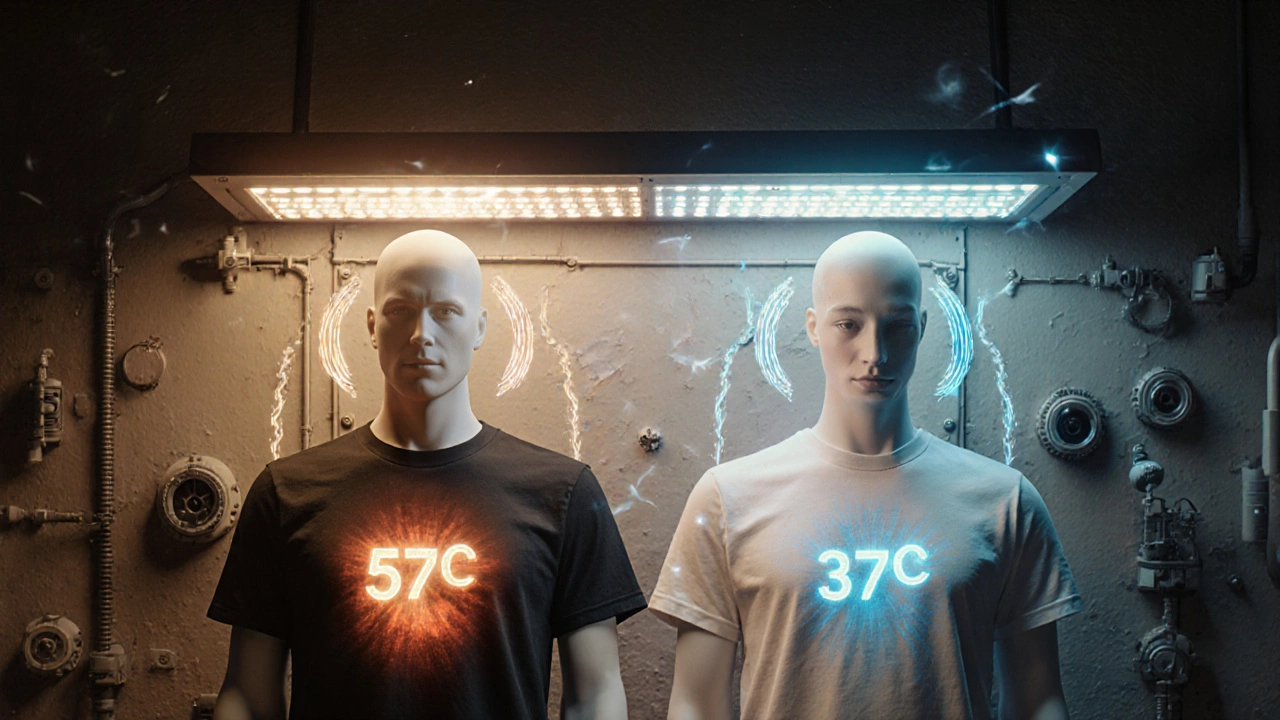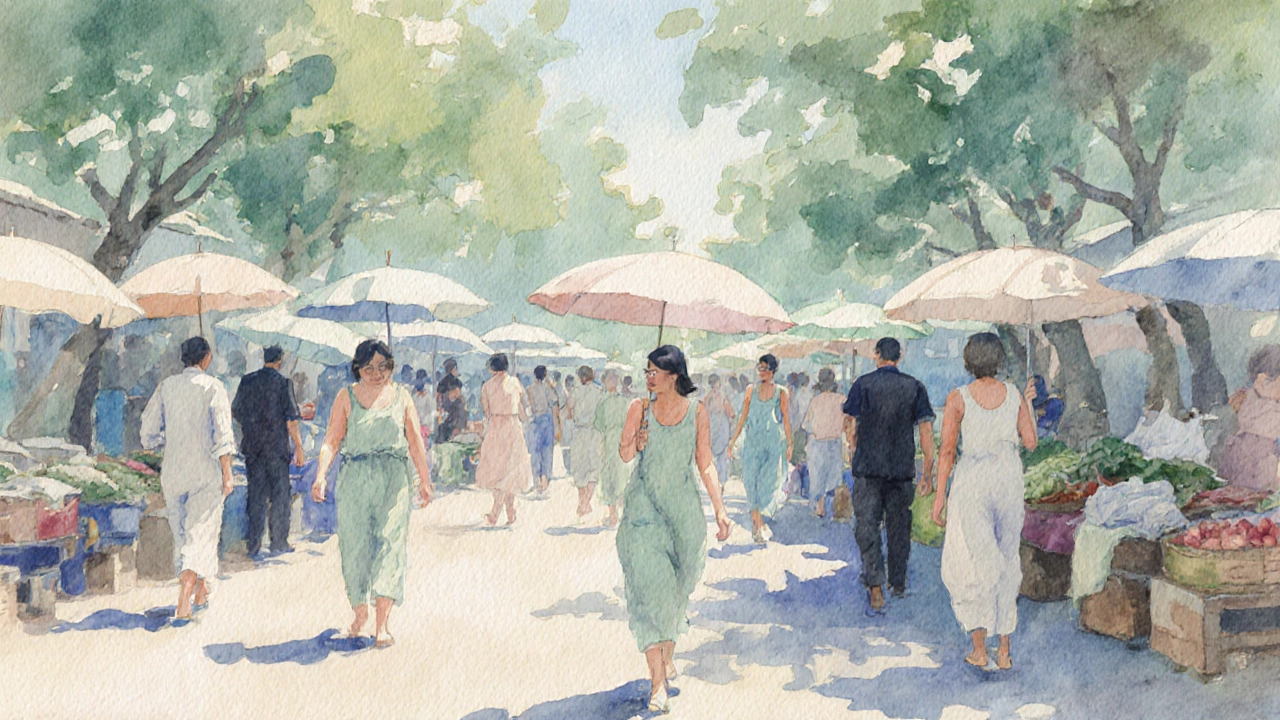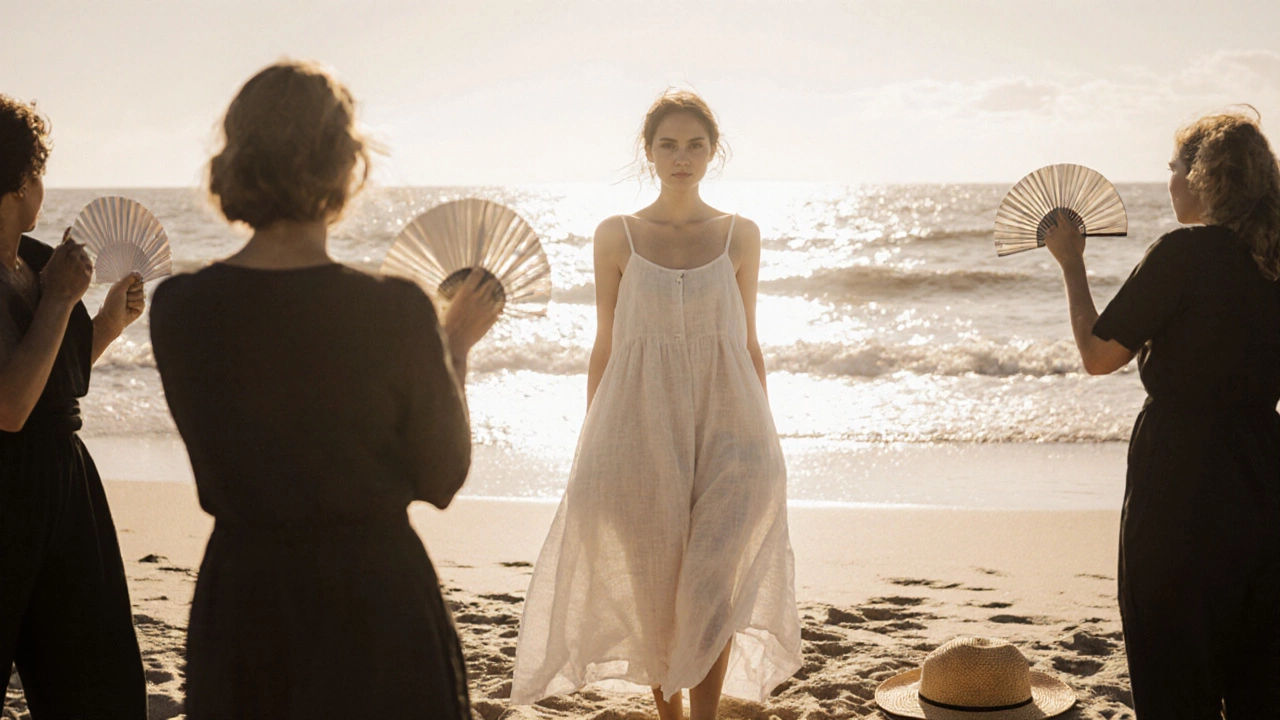When the sun beats down and the air feels thick, the right outfit can mean the difference between sweating through your day and staying cool enough to enjoy it. It’s not just about the fabric-it’s about the color. If you’ve ever worn a black shirt on a hot day and wondered why you felt like you were walking into an oven, you’re not alone. The truth is simple: light colors keep you cooler than dark ones. But it’s not that simple, and it’s not just about white.
Why color matters more than you think
Color affects how much sunlight your clothes absorb. Dark colors like black, navy, and deep red soak up almost all the visible light and turn it into heat. Light colors-white, cream, pastel pink, light blue-reflect most of that light away. That’s basic physics. Sunlight carries energy. When it hits your shirt, that energy has to go somewhere. Dark fabric turns it into warmth. Light fabric bounces it off.
Real-world tests back this up. In a 2018 study by the University of Arizona, researchers dressed identical mannequins in black, white, and gray cotton shirts and left them under a heat lamp simulating midday sun. After 30 minutes, the black shirt’s surface temperature hit 57°C (135°F). The white shirt? Just 37°C (99°F). That’s a 20-degree difference right on the fabric. Your skin, pressed against that fabric, doesn’t need to be a scientist to feel the difference.
What colors actually work best
White is the classic choice for a reason. It reflects up to 90% of visible light. But it’s not the only option. Light gray, beige, soft pastels, and even pale yellow all perform well. They don’t reflect quite as much as pure white, but they still bounce back enough heat to make a noticeable difference.
Here’s what to reach for:
- White - Best overall reflector. Ideal for beach days, outdoor markets, or long walks in the sun.
- Light blue - Reflects 70-80% of light. Also feels calming and looks fresh in summer.
- Pale pink or lavender - Reflects about 75%. Great for dresses and skirts that need to look pretty without cooking you.
- Beige or cream - Slightly less reflective than white but still good. Less likely to show sweat stains.
- Light gray - Reflects 60-70%. A smart middle ground between white and dark.
Even if you love bold colors, you can still stay cool. Look for pastel versions. A dusty rose dress is cooler than a crimson one. A mint green top is better than forest green. The key is brightness, not just lightness.
What colors to avoid
Black, dark brown, deep purple, navy blue, and charcoal gray are heat traps. They absorb 80-95% of sunlight. If you’re standing still in direct sun, these colors can make your skin temperature rise by 10-15°C compared to white. That’s the difference between feeling warm and feeling like you’re being slowly roasted.
Some people think dark colors are better because they “block UV rays.” That’s misleading. UV protection comes from fabric weave and chemical treatments, not color. A tightly woven white cotton dress can block just as much UV as a black one. Don’t trade comfort for a false sense of safety.
Fabric matters-even more than color
Color isn’t the whole story. A thick polyester dress in white will still trap heat. A thin, loose cotton dress in navy might feel cooler than a tight synthetic white one. You need both the right color and the right material.
Look for these fabrics:
- Cotton - Breathable, absorbs sweat, lets air flow. Best for everyday summer wear.
- Linen - Even more breathable than cotton. Wrinkles easily, but that’s part of the charm. Ideal for humid climates.
- Bamboo rayon - Soft, moisture-wicking, and naturally cooling. Often blended with cotton.
- Chambray - A lighter version of denim. Good for casual dresses and shirts.
Avoid: polyester, nylon, acrylic, and spandex blends. They’re designed for stretch and durability, not airflow. They trap sweat and heat like a sauna.

Fit and cut: the hidden factor
Even the whitest linen dress won’t help if it’s skin-tight. Air needs space to move. Loose fits create a small buffer between your skin and the fabric. That air layer acts like insulation-but in reverse. Instead of holding heat in, it lets heat rise and escape.
Choose:
- Flowy A-line dresses
- Wrap styles with open backs
- Maxi dresses with slits
- Off-the-shoulder or sleeveless cuts
These styles don’t just look summer-appropriate-they’re engineered for cooling. The more skin exposed to air, the better your body can regulate temperature.
Real-life examples from Auckland summers
Here in Auckland, summer days can hit 28°C with high humidity. On a Saturday at Mission Bay, you’ll see it all. Tourists in black leggings and tight tank tops are red-faced and fanning themselves. Locals? They’re in loose white cotton dresses, linen shirts, or pastel kaftans. One woman I saw wore a pale yellow linen dress with wide sleeves. She wasn’t sweating. She was laughing. That’s the power of smart choices.
Even at outdoor concerts or farmers markets, the people in dark colors are the ones asking for extra water. The ones in light colors? They’re still standing by the end of the day.
Myth busting: Do dark clothes protect you from the sun?
Some brands claim dark clothing offers better sun protection. That’s only partially true. Darker fabrics do block more UV radiation if the weave is tight and the material is dense. But here’s the catch: you can get the same protection from a light-colored, tightly woven cotton dress. In fact, the UPF (Ultraviolet Protection Factor) rating on clothing is based on fabric construction, not color.
So if you’re choosing between a white cotton dress with UPF 50+ and a black polyester dress with UPF 30, pick the white one. You get better sun protection and better cooling.

What about patterns and prints?
Patterns don’t change much. A white dress with small navy polka dots? The white areas still reflect most of the light. The navy dots absorb heat, but they’re small. The overall effect is still cool. Same goes for floral prints in pastels.
Big blocks of dark color? That’s different. A dress with a large black panel down the front will heat up faster than the rest. Stick to scattered patterns or all-over light tones.
What about accessories?
Your hat, bag, and shoes matter too. A wide-brimmed straw hat in natural fibers reflects heat and shades your face. A black sunhat? It’ll get hot enough to burn your scalp. Leather sandals are better than rubber soles-they breathe. Avoid plastic flip-flops; they trap heat under your feet.
Even your sunglasses can help. Dark lenses reduce glare, which makes your eyes less strained and your body feel less stressed overall. Less stress = less internal heat.
Final checklist: What to wear on a hot day
- ✅ Choose white, light blue, beige, or pastel colors
- ✅ Pick natural fabrics: cotton, linen, bamboo
- ✅ Go for loose, flowy cuts with open areas
- ✅ Avoid black, navy, and synthetic blends
- ✅ Wear a straw hat and natural-fiber sandals
- ✅ Skip tight fits, even in light colors
Summer isn’t about looking perfect. It’s about feeling comfortable. The right color and fabric don’t just keep you cool-they make you feel like you can breathe again. That’s worth more than any trend.
Do white clothes really keep you cooler than other colors?
Yes. White reflects up to 90% of visible sunlight, while black absorbs 95% or more. In direct sun, a white shirt can be 20°C cooler than a black one. That’s not just theory-it’s been tested with heat sensors on real fabric under sunlight.
Is it better to wear light colors or dark colors in humid weather?
Light colors are always better in humidity. High moisture in the air makes it harder for sweat to evaporate. Dark clothes trap heat, which makes your body work harder to cool down. Light colors reduce that heat load, giving your body a better chance to regulate temperature naturally.
Can I wear dark colors if the fabric is breathable?
Breathable fabric helps, but it doesn’t cancel out the heat absorption of dark colors. A linen dress in navy will feel cooler than a polyester one in black-but it’ll still be warmer than the same dress in white. Color still wins over fabric type when it comes to heat reflection.
Do patterns affect how cool a dress stays?
Small patterns with light backgrounds don’t change much. A white dress with tiny navy dots will still stay cool because the white areas dominate. But large patches of dark color-like a black panel or bold print-will absorb more heat. Stick to light-based patterns for best results.
What’s the best color for a summer dress if I want sun protection too?
Choose a light-colored dress made from tightly woven cotton or linen with a UPF 50+ rating. Color alone doesn’t guarantee UV protection-fabric construction does. A white cotton dress with UPF 50+ gives you the best of both: cooling and sun safety.

